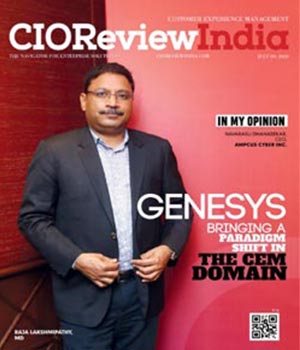
How to Use Customer Journey Mapping to Improve Customer Retention
Sudhakar Singh, Editor, CIOTechOutlook | Sunday, 18 February 2024, 13:57 IST

With the development of technology, 73 percent of customers today expect brands to personalize their offerings. As personalization assumes higher significance, customer experience is overtaking the criteria of price and product to become the most significant differentiator for brands. Brands that are improving their customer experience are successfully catapulting the customer retention rate. To understand the impact of enhancing customer retention, we can consider the fact that a mere 5 percent increase in customer retention rate can lead to 25 percent rise in the profits. This is why, for businesses to become and remain profitable, customer journey mapping is crucial. They can gain a competitive advantage by leveraging it to extract invaluable insights into customer behavior and their preferences.
As businesses increasingly become customer-centric, it is more important than ever to understand how customer journey mapping can be used to enhance customer retention.
Optimizing key touch-points
Customer journey mapping makes it easier for businesses to identify the key touch points where they need to channel their resources and energy. Once identified, these touch-points can be optimized. The customer effort for instance can be reduced significantly just by streamlining the touch points. As per Harvard Business Review, customer loyalty can be increased by as much as 94 percent by making the buying process effortless for the customer. Optimization of touch points also leads to better customer engagement with the brand. Research shows that companies having strong omni-channel customer engagement strategies in place are able to retain 89 percent of their customers whereas those who have not implemented such strategies retain only 33 percent.
One of the companies known to use the customer journey map and maintain high customer retention is Amazon. They provide the shoppers with the fast browsing and shopping, offer suggestions, and also ensure immediate customer response through answering their issues promptly. Through the highlighting of the seamless and painless experience, Amazon is developing lots of trust and loyalty in a way that makes the customer happy with the brand so that they always return for more purchases in the future.
Anticipating the needs
The customer journey map is the top most aspect for improving customer retention by putting the customers first. According to McKinsey research results, 3 out of 4 customers expect that companies should take into account the previous interactions and personal information to design the future experiences. Businesses that apply the right analytics method can foresee what a customer has interest in and provide customized services or solutions. One of the cases in point is Amazon's recommendation engine. This recommendation engine brings up to 35% of its sales. Customers will find it more convenient to get what they want beforehand, so they will be happy and eventually more loyal to the business. While 91% of consumers are more prone to buy from companies that are giving valuable offers and recommends products they need. This, as such, helps to effectively prepare for the demands of customers which thereby increases the clientele retention rate and ultimately boosts the organization's prosperity.
As an example, Starbucks provides evidence that customer journey mapping improves customer retention capability by anticipating the needs of the customer. Through the approach of mobile application, Starbucks finds out customers’ data and anticipates the tendencies and patterns. Take, for example, personalized notifications that suggest items to buy from previous orders, and grant a discount. The app's memorizing function, supporting reordering, singles out the previous purchases. Boosting the power of location data, Starbucks sends people timely notifications about the nearest coffee shop. Its proactive service is an asset that makes customers want to return and come back again.
Leveraging the feedback
The customer journey mapping helps integrate the customer feedback and retain customers. Findings of the Aberdeen Group have confirmed a 54 percent greater ROI for businesses adopting this approach. To start with, the data of feedback is collected during the critical moments and then it is analyzed to differentiate the obstacles and know the improvement areas. Research by Forrester has indicated several benefits of journey mapping that include increased customer satisfaction with 88 percent of enterprises witnessing the enhanced satisfaction following the adoption of journey mapping initiatives. Through systematic analysis of feedback pattern, more targeted improvement of customer experience is possible which consequently increases the retention rates. Undoubtedly, when 89 percent of companies get ready to experience more competition based on experience, journey mapping crafted with the use of input from customers ranks among the most vital practices that can help organizations maintain customer loyalty.
For example, Airbnb utilizes customer journey mapping as an important strategic tool to facilitate customer retention through media integration. It endeavors to implement user-centric improvements by systematically evaluating every interaction of users in their booking process and communications with the hosts. The company collects feedback from both the hosts and the tourists by surveying and reviewing, which provides the company with priceless insights about users’ preferences and pain points. The outcome of such analysis is a goal-directed action plan based on introduction of interface changes for the purposes of usability and provision of customer support services. The company seeks to continually improve and enhance the customer experience by employing user feedback as iterative steps towards loyalty and satisfaction.
“It is imperative that businesses in diverse domains make full use of the Internet as well as omni-channels to drive business expansion, productivity and profitability goals. Or they may risk being left behind in the race for relevance, market leadership and customer loyalty,” - Ankit Tandon, Chief Operating Officer, OYO Townhouse.
As data analytics and artificial intelligence develop, the future promises even more refined tools for business managers to decrypt customer encounters and responses. Predictive analytics will lead us to a more efficient approach where we can anticipate the potential problems and take proactive measures to prevent them happening in the first place. Integration with other upcoming technologies like augmented reality and virtual reality will enrich the customer experience, and provide them the immersive and interactive engagement. In the end, corporations that put a lot of effort into obtaining a grasp of the customer journey in its entirety and fine-tuning it would most likely succeed in maintaining their loyal customers and creating lasting connections in the digital world.
CIO Viewpoint
How The Sale of Counterfeit Products Can be...
By Khalid Wani, Senior Director, Sales, India- Western Digital
How Customer Experience Is Driving Supply Chain...
By Joseph Lim, Sales Director, APAC, BluJay Solutions
Connect to Customers - Customer Relationship...
By Satrajit Bhattacharya, IT Head, Future Group India
CXO Insights
How Omni-channel Customer Engagement Drives...
By Ankit Tandon, Chief Operating Officer, OYO Townhouse
By In conversation with CIOReview, Krishna Somayaji, MD, Somayaji Group talks about the group of companies
Which Segment of Analytics Space Can Drive the...










